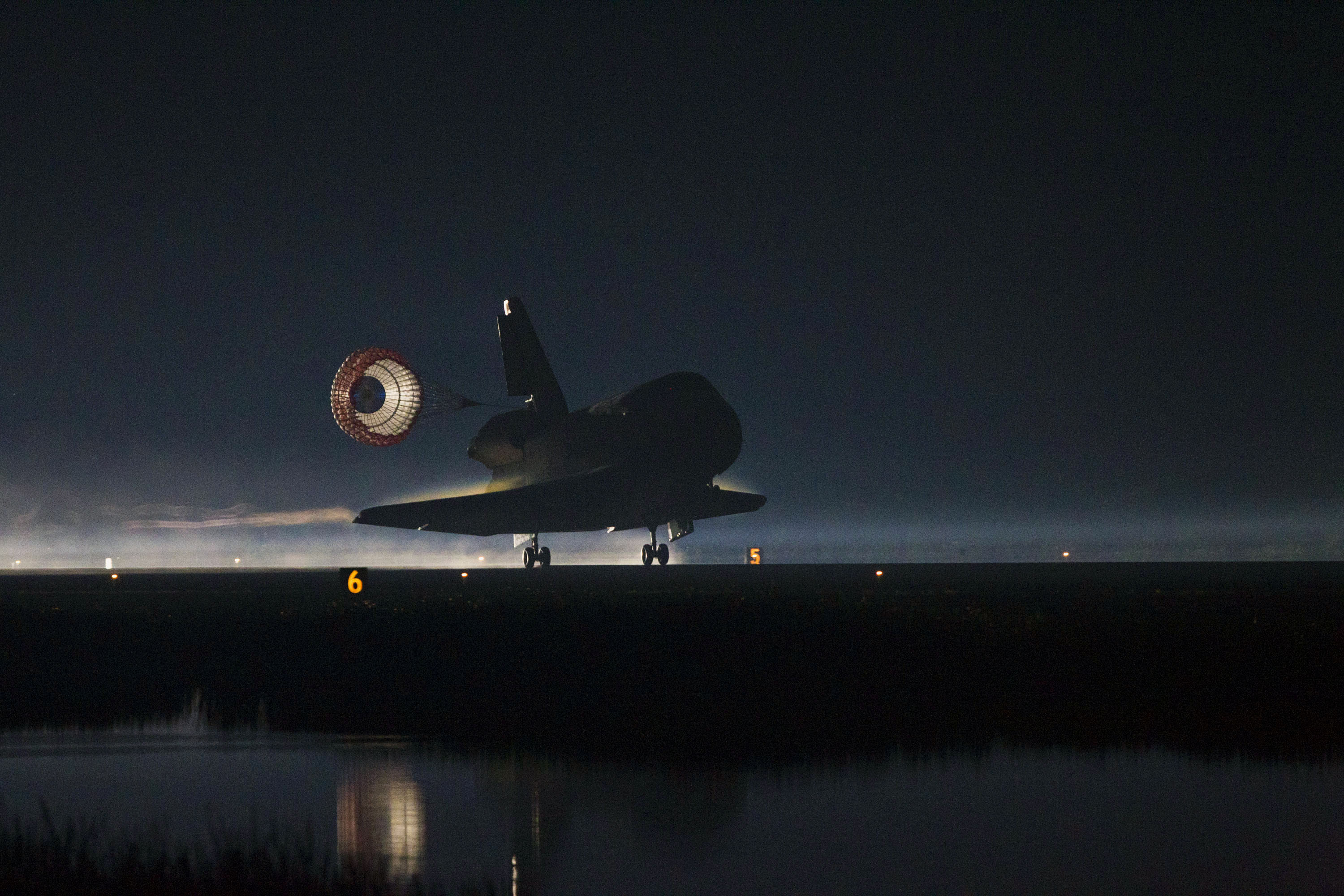
In the pre-dawn darkness of 21 July 2011, the small black-and-white dot of Atlantis glided smoothly into Florida airspace, bound for her final touchdown to close out the 30-year Space Shuttle Program. After almost 13 days in space, the four-strong STS-135 crew—Commander Chris Ferguson, Pilot Doug Hurley, and Mission Specialists Sandy Magnus and Rex Walheim—were wrapping up Atlantis’ 33rd spaceflight since her inaugural voyage, way back in October 1985, and concluding a remarkable career which had seen her visit the International Space Station (ISS) 12 times, visit Russia’s Mir orbital outpost a record-setting seven times, and visit the Hubble Space Telescope (HST) once. Today (Saturday, 3 October), NASA marks exactly 30 years since Atlantis’ maiden flight and AmericaSpace will commemorate this historic event with a series of five daily articles, through Wednesday, 7 October, to remember the five days of Mission 51J and to reflect upon the orbiter’s subsequent career.
Although the spectre of the end of the program had long hung over STS-135, this was sweetened somewhat by a spectacular mission. The final day in space for Ferguson, Hurley, Magnus, and Walheim had begun with “God Bless America” as the traditional wake-up music—which Capcom Shannon Lucid, herself a three-time Atlantis veteran, said was dedicated to all “the men and women who put their heart and soul into the shuttle program for all these years”—after which the crew pressed ahead with their de-orbit preparations. Generally good visibility and within-limits crosswinds at the Shuttle Landing Facility (SLF) at the Kennedy Space Center (KSC) in Florida prompted a “Go” for the irreversible de-orbit burn of Atlantis’ Orbital Maneuvering System (OMS) engines. For 197 seconds, beginning at 4:49 a.m. EDT, the two tail-mounted engines flared for the last time in space to effect sufficient deceleration as to drop the orbiter deeply into the sensible atmosphere, aiming for a touchdown on Runway 15 at 5:57 a.m.
At the darkened Cape, NASA Public Affairs Officer (PAO) Rob Navias provided a steady summary of the events, as Atlantis headed home for the last time. With less than nine minutes to go before touchdown, the air data probes on opposing sides of Atlantis’ nose—intended to collect pressure, altitude, angle-of-attack, airspeed, Mach numbers, and rate of descent to the shuttle’s on-board suite of General Purpose Computers (GPCs)—were deployed.
“Atlantis,” came the call from Capcom Barry “Butch” Wilmore, seated at his console in the Mission Control Center (MCC) at the Johnson Space Center (JSC) in Houston, Texas, “take air data.”
“Take air data,” acknowledged Ferguson.
Later, with under 69 miles (111 km) to go before Atlantis reached the SLF, Wilmore advised Ferguson that he was on-energy as he approached the Heading Alignment Circle (HAC) and confirmed that there were no changes to windspeeds or weather conditions and anticipated a nominal deployment of the shuttle’s drag chute. A few seconds of “stick-time” were afforded to Hurley shortly thereafter, and, descending at an angle seven times steeper than a commercial airliner, Atlantis headed into her final approach and her last minutes in flight. By 5:55 a.m., about 90 seconds before touchdown, Ferguson radioed Wilmore that he had visual on the runway. “Copy, Atlantis, field in sight,” replied Wilmore.
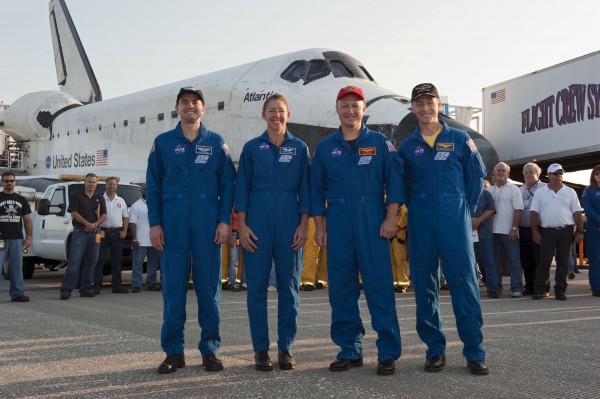
Heading home at 223 mph (359 km/h), Atlantis suddenly materialized from the gloom, like an enormous bird of prey, advancing on Runway 15. “Landing Gear down and locked,” Navias told his audience, seconds before the four wheels of the shuttle’s Main Landing Gear (MLG) hit the concrete at 5:57:00 a.m. “Main Gear Touchdown,” he continued. “Hurley now deploying the drag chute, Ferguson now rotating the nose gear down to the deck … Nose Gear Touchdown. Having fired the imagination of a generation, a ship like other, its place in history secure, the Space Shuttle pulls into port for the last time, its voyage at end.” It was difficult not to feel a lump in the throat as not only Atlantis’ career came to a close, but so too did that of the entire shuttle fleet, and even Navias’ voice quivered a little as the vehicle headed along the darkened runway towards Wheels Stop.
Atlantis ceased movement at 5:57:54 a.m., after a 54-second rollout. “Mission Complete, Houston,” radioed Ferguson. “After serving the world for over 30 years, the shuttle has earned its place in history and it has come to a final stop.”
“We congratulate you, Atlantis, as well as the thousands of passionate individuals across this great spacefaring nation, who truly empowered this incredible spacecraft, which has inspired millions around the globe.”
The day of her final return to Earth was indeed a bittersweet one for the entire NASA family, coming as it did after 135 cumulative flights, which had seen Atlantis deliver more than a dozen major satellite payloads—including the shuttle’s first planetary passengers, the Venus-bound Magellan and the Jupiter-headed Galileo spacecraft—into low-Earth orbit, bound for myriad destinations and roles. She had flown five dedicated missions for the Department of Defense, more than any of her other sisters in the shuttle fleet, and had played an integral part in the history of NASA’s “Great Observatories” program, by boosting the Compton Gamma Ray Observatory (CGRO) into orbit and conducting the final servicing visit to HST in May 2009. She injected the first satellites into orbit atop McDonnell Douglas’ upgraded Payload Assist Module (PAM)-D2 booster and supported the shuttle’s first and only use of the Stabilized Payload Deployment System (SPDS). Additionally, on STS-66 she deployed and retrieved the Shuttle Pallet Satellite (SPAS), equipped with the U.S./German Cryogenic Infrared Spectrometers and Telescopes for the Atmosphere (CRISTA), and, conversely, retrieved and deployed HST on STS-109.
Entering into a period of major modification as the first shuttle-Mir agreements were signed between the United States and Russia in the summer and fall of 1992, Atlantis found herself in the right place at the right time to receive structural enhancements which made her the first orbiter capable of docking with the Mir space station. Between June 1995 and October 1997, she visited Mir seven times, more than any of her sisters, and delivered the Docking Module (DM) to the Russian station. “Atlantis has a history of being the shuttle that did the most international things,” said lead Space Station flight director Emily Nelson, speaking before the vehicle’s STS-132 mission in May 2010. “It’s the orbiter that the Russians have known best, because it’s one that came to their space station most often and it’s one that we used to deliver a module for them in the past.”
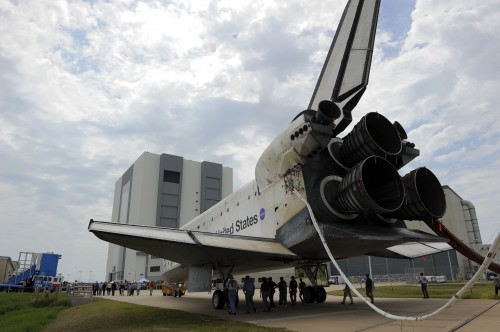
Atlantis later became the first vehicle to receive the Multifunction Electronic Display System (MEDS), which replaced her outdated suite of flight deck instruments and this was followed by 12 voyages to the ISS. Between May 2000 and July 2011, Atlantis’ visits to the ISS delivered much-needed supplies, installed the critical U.S. Destiny and European Columbus laboratory modules, the Quest airlock, and several key elements of the Integrated Truss Structure (ITS).
“I looked a little bit into Atlantis’ history and it’s very interesting,” recalled Chris Ferguson in the weeks preceding STS-135. “It was actually the most frequent visitor to Mir … so Atlantis really became the cornerstone of a docking operation with an orbiting space vehicle and, of course, it factored heavily into the construction of the International Space Station.” His crewmate Doug Hurley pointed out that Atlantis had “a proud legacy” and had “done the lion’s share of work with regard to the assembly,” whilst Rex Walheim added that “It’s got a great storied past and part of the Space Shuttle Program, first launching some interplanetary probes … and then doing Hubble repair … and then launching some of the heavy parts of the space station, too.” Walheim noted that his first mission, STS-110 in April 2002, carried the 44-feet-long (13.4-meter), 27,000-pound (12,250-kg) S-0 truss segment, which forms the centerpiece of the ITS. “It’s a very heavy component of the space station [and] was launched by Atlantis, because Atlantis has the capability of launching those heavy pieces.” Summing up, he added that the orbiter had “done a lot of the heavy lifting for the Space Station Program.”
Outwardly, Atlantis and her four sisters—Columbia, Challenger, Discovery, and Endeavour—are virtually identical, with the exception of various external markings. “They’re pretty much almost carbon copies of each other,” recalled Don Williams, who commanded Atlantis’ STS-34 mission in October 1989. “It’s like walking out on the flight line to an airplane. They may have different tail-numbers on them, but they all are pretty much the same.” Fellow astronaut Loren Shriver, who commanded both Discovery and Atlantis during his career, agreed: “All the vehicles, in terms of flying qualities and handling, are very similar to each other.” In correspondence with AmericaSpace last week, 51J astronaut Dave Hilmers, who flew both Discovery and Atlantis, remembered little difference, “either inside or outside”, adding that “they were pretty much identical twins.”
Others saw Atlantis and her sisters differently. STS-135’s Sandy Magnus flew aboard Atlantis twice and, as a long-duration ISS expedition crew member, also launched aboard Endeavour and landed aboard Discovery, and was not alone in her assertion that differences between the vehicles did exist. “It’s hard to put your finger on it,” she told a NASA interviewer in the weeks ahead of STS-135. “They all have their own little quirks and their own little personalities and it’s just hard to describe.” Veteran shuttle flier Fred Gregory—who piloted Challenger and commanded Discovery and Atlantis—went further. “Each of these ladies had slightly different personalities,” he told the NASA oral historian. “You could get inside and hear things on one that you wouldn’t hear on the other. But Discovery and Atlantis were very close to each other. There may be a few oddities, or some very few differences, between them, but … it would have been invisible for us to determine which one we were actually on.”
Atlantis’ multitude of crews, too, have transcended age, gender and nationality. All told, 148 discrete spacefarers voyaged into orbit and back aboard Atlantis from the United States, France, Russia, Canada, and Germany, as well as transporting the first-ever national representatives of Mexico, Belgium, Switzerland, and Italy beyond Earth’s “sensible” atmosphere and into space. That figure includes such luminaries as Jerry Ross, the only human to have flown Atlantis as many as five times, as well as three-time “Atlanteans” Shannon Lucid, Marsha Ivins, and Rex Walheim, and 35 others who traveled to and from orbit aboard the vehicle on two separate occasions during their careers. Of Atlantis’ “two-timers,” the list includes Frenchman Jean-Francois Clervoy, the first Hispanic-American astronaut, Franklin Chang-Diaz, and the man who commanded the first shuttle-Mir docking mission, Robert “Hoot” Gibson. And a handful of this number—veteran astronauts Mary Cleave, Steve Frick, Rex Walheim, Leland Melvin, and Mike Good—flew their entire multiple-mission careers solely aboard Atlantis.
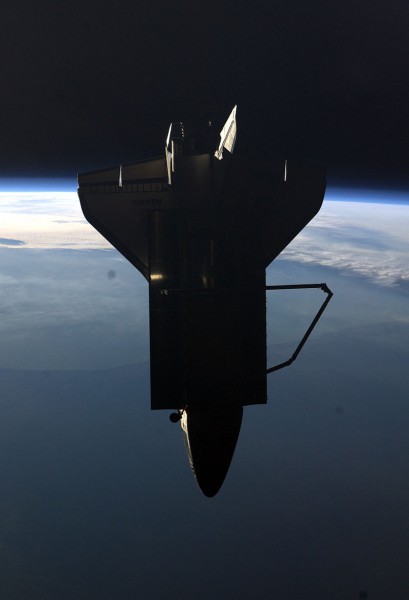
Yet these figures only serve to describe those men and women who actually launched and landed on Atlantis. Several others rode into orbit aboard her, yet returned to terra firma within the confines of another craft; either a different member of the shuttle fleet or a Russian Soyuz spacecraft. Their number includes cosmonauts Anatoli Solovyov and Nikolai Budarin, together with Frenchman Leopold Eyharts and U.S. astronaut Clay Anderson. Conversely, Russia’s Vladimir Dezhurov and Gennadi Strekalov and U.S. astronauts Suni Williams, Dan Tani, and Nicole Stott only ever landed aboard Atlantis, having received their ticket into space aboard other vehicles. Carrying this peculiarity a step further, astronaut Dave Wolf is unique in that he launched twice, but only ever landed once, aboard Atlantis during his career—having returned from a long-duration Mir occupancy aboard a different shuttle—whilst Norm Thagard offers an opposing perspective of polarity: as the first American ever to launch aboard a Soyuz, he landed twice, but only ever launched once, on Atlantis.
Confused yet? You should be, for more than half of Atlantis’ 33 missions saw her rendezvous and dock with either Mir or the ISS and the consequence was that 29 other spacefarers— including the first ISS Commander, Bill Shepherd, the first European ISS Commander, Frank de Winne, and the first female ISS Commander, Peggy Whitson—were on hand to welcome her after docking in orbit. Interestingly, ten individuals happened upon Atlantis on more than one mission during their careers: including Germany’s Thomas Reiter, who witnessed her arrival at both Mir on STS-74 and at the ISS on STS-115, and Russian cosmonaut Valeri Korzun, the only human to have boarded Atlantis three times in space, but never to have actually launched or landed aboard her.
All told, 131 men voyaged to and from orbit aboard Atlantis. Of that number, the oldest was 59-year-old Frenchman Jean-Loup Chretien on the STS-86 shuttle-Mir docking mission in the fall of 1997, whilst the youngest was Scott Parazynski, who pipped 51J’s Bill Pailes by a just single day when he launched aboard STS-66 in November 1994, aged 33 years and 99 days. And in terms of pilots and commanders, the oldest person ever to lead an Atlantis mission was Fred Gregory, who was five weeks shy of his 51st birthday, when he relinquished command of STS-44 in December 1991, whereas the youngest was Brewster Shaw, who headed the orbiter’s second flight, Mission 61B and was aged 40 years and 194 days at the time of his launch in November 1985. Seventeen women have launched and landed aboard Atlantis, including Ellen Ochoa—the first female Hispanic-American spacefarer and today’s Director of the Johnson Space Center (JSC)—and Russian cosmonaut Yelena Kondakova. The orbiter’s oldest female crew member was Shannon Lucid, aged 53, when she launched and landed aboard Atlantis’ STS-76 and STS-79 missions in March and September 1996, whilst the youngest was Ellen Baker, who was 36 years and 174 days old when she rocketed into orbit on STS-34 in October 1989.
Those 148 souls who journeyed to and from orbit aboard Atlantis, joined by the few tens of others who occupied her only during ascent or only during re-entry, or who boarded her only whilst she was in space, make a grand total of 187 humans from eight sovereign nations who have flown her. As circumstances transpired, Atlantis was the last shuttle to travel into space, but, as will be explored in tomorrow’s AmericaSpace commemorative article, she was originally meant to be the youngest and final member of the fleet to fly. Thirty years ago, this week, a long and prosperous career stretched ahead of Atlantis. Yet it would be a career whose twists and turns no one could have ever anticipated.
The second part of this five-part article will appear tomorrow.
Want to keep up-to-date with all things space? Be sure to “Like” AmericaSpace on Facebook and follow us on Twitter: @AmericaSpace




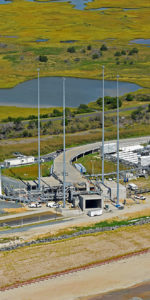
The ATLANTIS exhibit at the KSC Visitor Complex is spectacular, IMO. I urge all to see it.